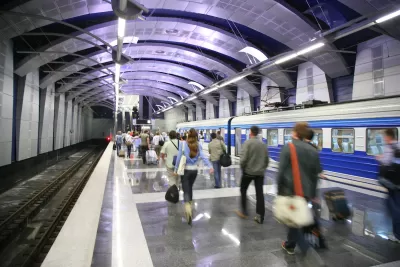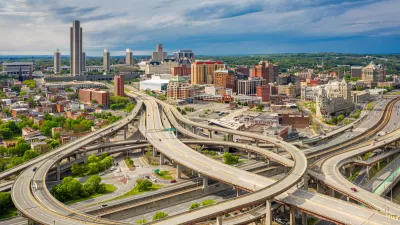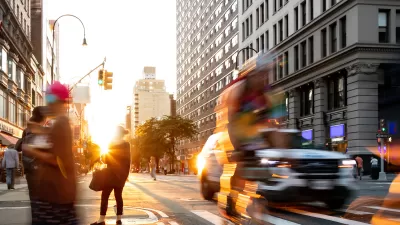This Union of Concerned Scientists study examines why and how to improve resource-efficient travel options to achieve diverse goals. It estimates that more efficient transport could save up to $201 billion in energy and $128 billion in health costs.

The new Union of Concerned Scientists study, Freedom to Move: Investing in Transportation Choices for a Clean, Prosperous, and Just Future, shows that a transportation system that gives everyone more transportation choices will be more equitable, save trillions of dollars, and fight climate change. More transportation options such as transit, walking and biking are good for the environment, economy, and social equity.
It finds that:
-
A system with improved transportation options and reduced driving could save up to $201 billion in energy infrastructure and $128 billion in public health costs through 2050, presenting a more effective climate solution than the current car-dependent model.
-
The auto and oil industries have a vested interest in car dependence, currently receiving more than 75 percent of public and private transportation spending and have lobbied for decades to prioritize cars over a more complete and affordable set of transportation options.
-
Science-based policies that prioritize more transportation choices align with community-based solutions where local advocates have long fought for a transportation system that prioritizes people over industry interests.

Recommendations
-
Invest in a complete set of transportation options for a system that offers abundant access to everywhere we need to go and promotes economically thriving communities in both urban and rural areas. This means investing in networks of safe sidewalks for pedestrians, paths for biking and micromobility, and frequent, wide-ranging, affordable, and clean public transportation. These efforts depend on promoting land use changes that allow people to live near high-quality transit without displacement, dismantling structural racism in community safety, and ensuring good jobs with high labor standards.
-
Prioritize transportation projects in rational ways, including the extent to which they help achieve climate goals, reduce harm to communities experiencing the greatest impacts, and improve access for those who need it the most. This will necessarily mean meeting more rigorous standards for expensive, high-polluting highway expansion projects that commit us to high maintenance costs. Instead, we must first address the backlog of existing infrastructure maintenance. Also, state departments of transportation and metropolitan planning organizations must be accountable and transparent in their decisionmaking on what gets built.

-
Make transportation decision-making processes representative, and meaningfully engage the people and communities most affected by proposed projects. For decades, the auto, fossil fuel, and road-building industries have profited from excessive highway expansion and denied us choice in transportation. All of us, whether Black, brown, or White, whether US-born or immigrant, deserve to have a seat at the table to ensure transportation projects truly benefit our communities.
FULL STORY: Freedom to Move

Manufactured Crisis: Losing the Nation’s Largest Source of Unsubsidized Affordable Housing
Manufactured housing communities have long been an affordable housing option for millions of people living in the U.S., but that affordability is disappearing rapidly. How did we get here?

Americans May Be Stuck — But Why?
Americans are moving a lot less than they once did, and that is a problem. While Yoni Applebaum, in his highly-publicized article Stuck, gets the reasons badly wrong, it's still important to ask: why are we moving so much less than before?

Using Old Oil and Gas Wells for Green Energy Storage
Penn State researchers have found that repurposing abandoned oil and gas wells for geothermal-assisted compressed-air energy storage can boost efficiency, reduce environmental risks, and support clean energy and job transitions.

Greening Oakland’s School Grounds
With help from community partners like the Trust for Public Land, Oakland Unified School District is turning barren, asphalt-covered schoolyards into vibrant, green spaces that support outdoor learning, play, and student well-being.

California Governor Suspends CEQA Reviews for Utilities in Fire Areas
Utility restoration efforts in areas affected by the January wildfires in Los Angeles will be exempt from environmental regulations to speed up the rebuilding of essential infrastructure.

Native American Communities Prepare to Lead on Environmental Stewardship
In the face of federal threats to public lands and conservation efforts, indigenous groups continue to model nature-centered conservation efforts.
Urban Design for Planners 1: Software Tools
This six-course series explores essential urban design concepts using open source software and equips planners with the tools they need to participate fully in the urban design process.
Planning for Universal Design
Learn the tools for implementing Universal Design in planning regulations.
Heyer Gruel & Associates PA
City of Moreno Valley
Institute for Housing and Urban Development Studies (IHS)
City of Grandview
Harvard GSD Executive Education
Salt Lake City
NYU Wagner Graduate School of Public Service
City of Cambridge, Maryland




























